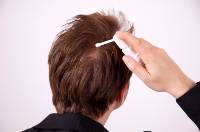There are 5 basic categories of alopecia treatments: dietary supplements, topically applied treatments, systemic medications, hair transplantation and non-surgical hair replacement.
Dietary supplements generally fall into the “natural remedy” class of hair loss treatments. Some types of hair loss are caused by an overabundance of a hormone called DHT (dihydrotestosterone). DHT attacks the hair follicle, causing the individual hair to grow in thinner and thinner, until the follicle eventually stops producing hair. DHT causes the most common type of hair loss, commonly referred to as “male pattern baldness.”
Click Here To Discover The Best Alopecia Treatment For You!
If the action of DHT can be slowed or stopped, there’s a better chance hair will be retained. Among dietary supplements, saw palmetto is a very popular DHT blocker. Other supplements to consider are based on either green tea or stinging nettle. If possible, try to find a product that combines 2 or more of these together. You can, of course, take green tea in its traditional form as a beverage. Alopecia treatments of this type are easy to use, non-invasive and completely natural.
Topically applied alopecia treatments can be natural or man-made. Saw palmetto, for example, can be applied topically by using shampoos, conditioners or serums. Perhaps the best-known topical remedy is minoxidil, sold under the brand name Rogaine®. Originally a prescription drug but now widely available over the counter, minoxidil has been clinically proven to slow down or halt hair loss. In some cases, hair actually regrows. Another DHT blocker, minoxidil must be used on a daily basis to remain effective. It comes in 2 strengths, 2% and 5%.
Among systemic medications, the prescription drug finesteride, sold under the name Propecia®, has been successful. The usual dosage is 1 mg taken once per day. This medicine is most effective for men with thinning hair, not men who are bald or nearly bald. Finesteride is a chemical DHT blocker, clinically proven among alopecia treatments to slow or stop hair loss. Treatment with finesteride takes time, up to a year. You must continue taking the drug or the benefits will reverse themselves, again within a year.
If DHT blockers or other alopecia treatments aren’t effective for you, consider hair transplantation. This is a surgical process where healthy hair, follicle and all, is taken from an area of the scalp where hair is plentiful and relocated to an area where hair is thinning, such as the hairline. A good surgeon can significantly restore your hairline, giving it a completely natural look. Done as an outpatient procedure, hair transplantation is an artistic process as well as a medical one.
Non-surgical hair replacement involves wigs, hair pieces and the hair weaving process. In hair weaving, individual synthetic strands are attached to existing hairs, again in an artistic manner. Hair weaves are virtually undetectable but do require maintenance every 3 – 5 weeks. You can swim and shower with a weave, just as you would with natural hair. Hair weaves are popular alopecia treatments among men who want more volume and fullness than they could get from transplants.
Choose among alopecia treatments carefully. Be sure that what you choose has a proven record of reasonable success.

